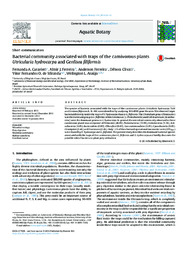Bacterial community associated with traps of the carnivorous plants Utricularia hydrocarpa and Genlisea filiformis.
Bacterial community associated with traps of the carnivorous plants Utricularia hydrocarpa and Genlisea filiformis.
Author(s): CARAVIERI, F. A.; FERREIRA, A. J.; FERREIRA, A.; CLIVATI, D.; MIRANDA, V. F. O. de; ARAÚJO, W. L.
Summary: The species of bacteria associated with the traps of the carnivorous plants Utricularia hydrocarpa Vahl and Genlisea filiformis A. St.-Hil. were identified by analysing 16S rRNA gene libraries. We observed larger bacterial diversity inside the traps of U. hydrocarpa than in G. filiformis. The Clostridium genus (Firmicutes) was the dominant group in G. filiformis, while Aeromonas (γ-Proteobacteria) and Acidobacterium (Acidobacteria) were the dominant genera in U. hydrocarpa. In general, the microbial community observed in these carnivorous plants was composed of Firmicutes (46.8%), Proteobacteria (33.9%), Acidobacteria (9.3%), Actinobacteria (4.4%), Bacteroidetes (0.8%), Chloroflexi (0.4%), Gemmatimonadetes (0.4%), Cyanobacteria (0.4%), Chlamydiae (0.4%) and Tenericutes (0.4%). Only 1.2% of the observed operational taxonomic units (OTU0.03) were shared by U. hydrocarpa and G. filiformis. The present study describes the dominant bacterial species associated with the traps of the carnivorous plant G. filiformis and U. hydrocarpa and briefly discusses the possible role of bacteria in plant prey utilisation.
Publication year: 2014
Types of publication: Journal article
Keywords: Microbial ecology, Microbiologia
Observation
Some of Embrapa's publications are published as ePub files. To read them, use or download one of the following free software options to your computer or mobile device. Android: Google Play Books; IOS: iBooks; Windows and Linux: Calibre.
Access other publications
Access the Agricultural Research Database (BDPA) to consult Embrapa's full library collection and records.
Visit Embrapa Bookstore to purchase books and other publications sold by Embrapa.

